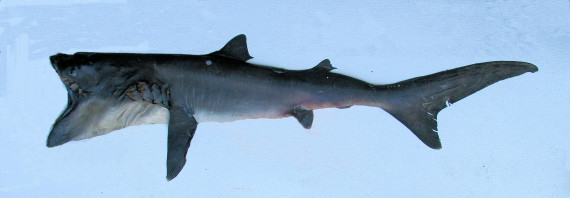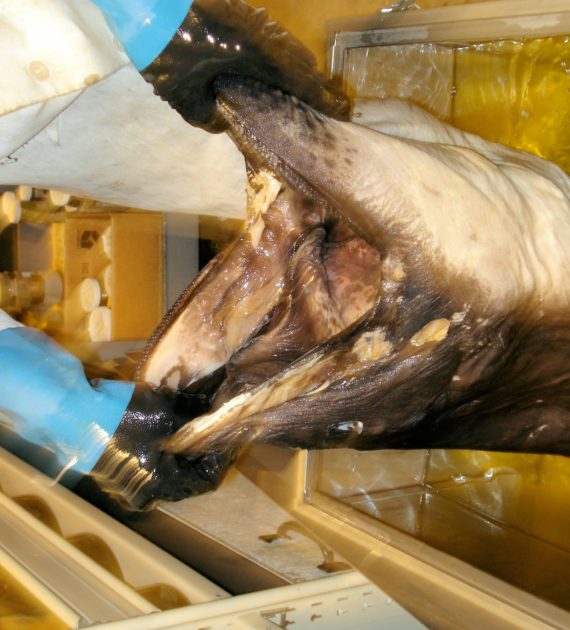Megamouth Shark, Megachasma pelagios

 Megamouth Shark, Megachasma pelagios, Female. Fish caught off the coast of Tortugas Bay, Baja California Sur, by commercial fishermen in a gill net, November 16, 2006. Length: 2.15 m (7 feet 1 inch) and 27 kg (60 lbs). Identification courtesy of Jośe Leonardo Castillo-Géniz, National Fisheries Institute of Mexico, Ensenada, Baja California. Photographs courtesy of Dan Cartamil, Scripps Institution of Oceanography, La Jolla, California.
Megamouth Shark, Megachasma pelagios, Female. Fish caught off the coast of Tortugas Bay, Baja California Sur, by commercial fishermen in a gill net, November 16, 2006. Length: 2.15 m (7 feet 1 inch) and 27 kg (60 lbs). Identification courtesy of Jośe Leonardo Castillo-Géniz, National Fisheries Institute of Mexico, Ensenada, Baja California. Photographs courtesy of Dan Cartamil, Scripps Institution of Oceanography, La Jolla, California.
The Megamouth Shark, Megachasma pelagios, is a member of the Megamouth Shark or Megachasmidae Family, and is known in Mexico as tiburón bocón. It is only species in the genus Megachasma. The Megamouth Shark is one of three giant filter feeding sharks in the sea; the Basking Shark, Cetorhinus maximus and the Whale Shark, Rhincodon typus, being the other two. The Megamouth Shark is an exceedingly rare species with the first collection made by a United States Navy ship in Hawaiian waters on November 15, 1979. The second collection was not made until eight years later. As of January 2015, only sixty specimens have been documented. They are considered the most primitive of the living sharks within the order Lamniformes which includes the Basking Sharks, the Crocodile Sharks, the Goblin Sharks, the Mackerel Sharks, the Sand Sharks, and the Thresher Sharks.
The Megamouth Shark has a stout soft flabby body that tapers posteriorly. They are black-brown overall and transition to white ventrally. The tips of their anal, caudal, and dorsal fins are white. They have a bright white band on their snout just above the upper jaw. Their head is wide, bulbous, and long, and features semi-circular eyes and a very short broadly rounded snout. Their mouth is broad, terminal, and over 4 feet wide; it extends beyond the eyes with huge jaws and approximately 50 rows of numerous small hooked teeth. Their gill slits are moderately long and lined with dense rows of papillose gill rakers. They have a row of photophores surrounding their mouth which are believed to attract plankton. Their anal fin is small; their caudal fin is asymmetrical with a pronounced lower lobe; their first dorsal fin is about twice the size of the second dorsal fin and closer to the pectoral fin base than to the pelvic fin base; and, their pectoral fins are short. Their skin is covered with small denticles.
The Megamouth Shark is found both near the surface and at depths up to 600 m (1,970 feet). They reach a maximum of 5.5 m (18 feet) in length and can weigh up to 1,216 kg (2,680 lbs). They are filter feeders and poor swimmers, therefore they move along slowly at about 1 mph with their mouth wide open. They feed primarily on krill and to a lesser extent on copepods, small fish and jellyfish. They follow their prey by migrating toward the surface at night and returning to the ocean depths during the day. They are preyed upon by Sperm Whales and Cookiecutter Sharks. Parasites have been found on and within the Megamouth Sharks. Their reproduction process is not well-understood, but is believed to be ovoviparous and include a large number of cream colored eggs with embryos being fed on the yolk sac and other ova produced by the mother. Pups are less than 1.8 m (5 feet 11 inches) at birth. Males have relatively slender claspers with elongated tips. The Megamouth Shark is exceedingly rare, seldom seen my humans, and very limited information available about their lifestyle and behavioral patterns including specific details on age, growth, longevity, movement patterns, diet, habitat use, and reproduction.
The Megamouth Shark is a resident of the Pacific but has only been documented off the west coast of central Baja.
The Megamouth Shark s are most likely confused with young Killer (Orca) Whales.
From a conservation perspective the Megamouth Shark is currently considered to be Data Deficient with very limited information being available their distribution and population.